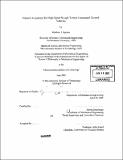Hazard avoidance for high-speed rough-terrain unmanned ground vehicles
Author(s)
Spenko, Matthew J. (Matthew Julius), 1976-
DownloadFull printable version (19.92Mb)
Other Contributors
Massachusetts Institute of Technology. Dept. of Mechanical Engineering.
Advisor
Steven Dubowsky.
Terms of use
Metadata
Show full item recordAbstract
High-speed unmanned ground vehicles have important applications in rough-terrain. In these applications unexpected and dangerous situations can occur that require rapid hazard avoidance maneuvers. At high speeds, there is limited time to perform navigation and hazard avoidance calculations based on detailed vehicle and terrain models. Furthermore, detailed models often do not accurately predict the robot's performance due to model parameter and sensor uncertainty. This thesis presents the development and analysis of a novel method for high speed navigation and hazard avoidance. The method is based on the two dimensional "trajectory space," which is a compact model-based representation of a robot's dynamic performance limits on natural terrain. This method allows a vehicle to perform dynamically feasible hazard avoidance maneuvers in a computationally efficient manner. This thesis also presents a novel method for trajectory replanning, based on a "curvature matching" technique. This method quickly generates a path connects the end of the path generated by a hazard avoidance maneuver to the nominal desired path. Simulation and experimental results with a small gasoline-powered high-speed unmanned ground vehicle verify the effectiveness of these algorithms. The experimental results demonstrate the ability of the algorithm to account for multiple hazards, varying terrain inclination, and terrain roughness. The experimental vehicle attained speeds of 8 m/s (18 mph) on flat and sloped terrain and 7 m/s (16 mph) on rough terrain.
Description
Thesis (Ph. D.)--Massachusetts Institute of Technology, Dept. of Mechanical Engineering, 2005. "June 2005." Includes bibliographical references (p. 111-116).
Date issued
2005Department
Massachusetts Institute of Technology. Department of Mechanical EngineeringPublisher
Massachusetts Institute of Technology
Keywords
Mechanical Engineering.